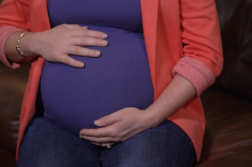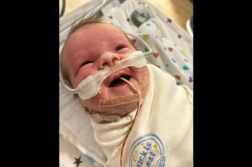Interventional Radiologist at Northwestern Medicine, Robert Vogelzang, MD, talks about removing fibroids without a hysterectomy.
Interview conducted by Ivanhoe Broadcast News in 2023.
What are fibroids and how common are they?
Vogelzang: Fibroids are very common, benign, that is not malignant tumors arising from the muscle of the uterus. They’re seen in every age group, more particularly in women in their 40s and 50s although we do see some earlier and they’re very common in specific groups of individuals. They are seen more often in families. They’re seen in certain ethnic groups, very commonly in African-American women. But they’re a huge public health problem and they’re seen broadly, it’s said well over 80 percent of women will have some finding of fibroid in their life.
They can become quite debilitating, explain what these portions can experience.
Vogelzang: Fibroids produce two types of symptoms. It’s said that women will develop one or the other or both types of symptoms. The symptoms are bleeding and bulk. Bleeding is heavy menstrual periods, cramping, excessive bleeding, anemia, and blood loss. Bulk is everything else that involves the uterus enlarging. As these tumors grow in the uterus, the uterus expands, and in that area, there are a lot of adjacent organs. For example, the bladder. It can compress the bladder and produce urinary frequency. It can compress the colon and produce constipation. It can produce pain from adjacent pelvic nerves or pain on its own. Bleeding and bulk are the two principal symptoms. It’s said that one-third of women have bleeding, only one-third of women have bulk, and one-third of women have both of those symptoms.
How are they commonly treated?
Vogelzang: Commonly, that is to say for the most part in much of America, they’re treated by hysterectomy. Hysterectomy is still the go-to procedure for the vast majority of American women, which is a sad state of affairs, given the fact that we have many other ways to preserve the uterus for very important medical, psychological, and reproductive reasons. But hysterectomy is still the vastly most common procedure recommended and done. But there are other ways to treat them. One of them we do here is uterine fibro and embolization. That’s widely done in other areas in the right circumstances and by the right physicians, but also myomectomy, which is a surgical removal of fibroids.
Then you developed a new way to treat them, can you explain?
Robert Vogelzang: We’ve really developed a new combination of things to treat fibroids. Here at Northwestern, we no longer automatically assume that a hysterectomy is the only way. As a matter of fact, if a woman is told that hysterectomy is her only option, she should absolutely get a second opinion. Because we now have methods including embolization, which is the shrinkage of fibroids by blocking the blood supply, and myomectomy, which can be done through open surgery, that is, through incision or using laparoscopy. But our advance here has been the combination of these two to preserve the uterus and allow women to become symptom-free without the need for a hysterectomy.
This is a combination of UFE and myomectomy. Why is it better?
Vogelzang: It’s better because you preserve the uterus. The uterus is just not a disposable organ. It’s felt to be that way by many American physicians and they’re just wrong. Most women can avoid a hysterectomy. It’s not just fondness for an organ that you don’t want to part with or that gave you your children. It’s about overall pelvic health. Hysterectomy we know is associated with some significant downstream complications. For example, women who have hysterectomies have a 15 to 20 percent higher risk of pelvic floor dysfunction. What that means is basically, pelvic floor descent, urinary stress, incontinence, that is leakage when you cough or laugh or strain. We also know, for example, that women who have hysterectomies, even if you leave the ovaries in, go into menopause several years earlier than women who do not. Finally, there are clearly some sexual side effects. Declines in sexual function or sexual desire because of hysterectomy despite what many gynecologists will say. Our view is avoid a hysterectomy if at all possible and it’s definitely possible using the methods that we’ve outlined including myomectomy, uterine fibroid embolization, and even a combination with drugs and the procedures I just mentioned.
You say the uterus while doing this, what does that mean for these women?
Vogelzang: It’s simple, you get to keep an important part of your overall pelvis. It has a great deal to do with overall pelvic sexual and reproductive health. You can continue to have reproduction after this procedure. Obviously, you can’t have a child after a hysterectomy. Saving the uterus is a big deal in terms of reproductive outcomes. If you can remove fibroids, and shrink them, you can return the uterus to a more normal state and allow many women to get pregnant, which we’ve had many such successes over the last 30 years here at Northwestern.
Are there any risks to this?
Vogelzang: They’re a typical surgical risk, but they’re relatively minor. Certainly, they’re no greater than the risk of hysterectomy, which is open surgery. The risk for both myomectomy and embolization, especially performing it as we do with, for example, minimally invasive methods. We do laparoscopic removal of the fibroid and embolization involves simply puncture of an artery. Yes, the complication rate is less. It’s not zero, but it’s certainly less and compared to, for example, hysterectomy, it’s an improvement.
Who are the best candidates and are any women not good candidates for you?
Vogelzang: Any woman with fibroids should be evaluated with this in mind for a uterine-sparing procedure. We consider all these either used singly or in combination to be uterine-sparing. We think that’s a good thing as I said. We just don’t think the uterus is a disposable organ as I’ve mentioned. But women who are candidates should be screened and they should see their gynecologist or see certainly a center like ours and that evaluation will take place with a combination of clinical exam as well as imaging. For example, MRI, which gives us a great deal of information about the uterus and the suitability for these procedures.
We’re talking about Angela Lamandi, can you talk about her story?
Vogelzang: Ms. Lamandi is a typical patient. We’ve seen many such patients as her. She has a symptomatic fibroid and wishes to preserve her uterus and doesn’t want a hysterectomy. If I’m not mistaken, she was told, as so many of our patients who come and see us were told, all you can have is a hysterectomy. That’s frankly false. We evaluated Ms. Lamandi and we determined that the fibroid was best treated by removal, but first by taking away its blood supply with the procedure that I do, which is called uterine fibroid embolization. The fibroid then shrunk, decreased blood loss was achieved, and the myomectomy could be achieved with minimal blood loss and very low complication rate.
Her fibroid was pretty large, do you remember the size?
Vogelzang: Yeah, I remember it was about three to four inches, maybe a little larger. It’s not so much the size, although that’s important. It’s where it was and the symptoms that it was producing. Our determination was that removal of the fibroid would be the best option for her.
Were you able to use the procedure?
Vogelzang: Yes, we were. It’s a combined method using interventional radiology methods, meaning uterine fibroid embolization, and the skill of the surgeons, Dr. Millard and others in the Center for Advanced Gynecology here at Northwestern Medicine. We were able to do it and accomplish it nicely and she had a terrific outcome.
What does it mean for her that she was able to keep her uterus?
Vogelzang: Well, keeping your uterus is a good thing in and of itself, but reproduction is now achievable if she wishes to do so. Above all, her symptoms are relieved, and she did not have to undergo hysterectomy.
Was she the uterus for fibroids?
Vogelzang: Yes. What I always say to patients is that your uterus is the organ that wants to grow fibroids. We treat the current group of fibroids. But typically, we’ve found that in a woman of Ms. Lamandi’s age, if we treat this time, the likelihood of her regrowing fibroids is very small. Having said that, however, if she did regrow fibroids, we could repeat this procedure again. We could do this procedure again, as we’ve done many, many times in other patients. I have several patients, we’ve done repeat fibrodymbolizations at seven-year intervals. I have one patient, well, more than one, who have done three fibroidembolizations. We’ve achieved elimination of the fibroid symptoms and avoidance of hysterectomy.
Anything I’m missing or any important information?
Vogelzang: No. I would just say, don’t believe your gynecologist if they say hysterectomy, is the only option. That is no longer a modern and appropriate approach for a woman with fibroids. If you have fibroids and you have symptomatic fibroids that your doctor has said, all you can have is a hysterectomy and if your doctor does not give you some other options, get a second opinion.
Only in regard to Ms. Lamandi’s case and I had to characterize it, was it average? Was her situation dire? What was her diagnosis of the situation?
Vogelzang: She was a typical woman with fibroids who wanted to avoid hysterectomy and preserve her uterine function. In that sense, she’s somebody we’ve seen a number of situations- we’ve done in a number of circumstances. She’s a woman we’ve treated in the same way many other times in many other forms.
END OF INTERVIEW
This information is intended for additional research purposes only. It is not to be used as a prescription or advice from Ivanhoe Broadcast News, Inc. or any medical professional interviewed. Ivanhoe Broadcast News, Inc. assumes no responsibility for the depth or accuracy of physician statements. Procedures or medicines apply to different people and medical factors; always consult your physician on medical matters.
If you would like more information, please contact:
Erin Valle
Sign up for a free weekly e-mail on Medical Breakthroughs called First to Know by clicking here




